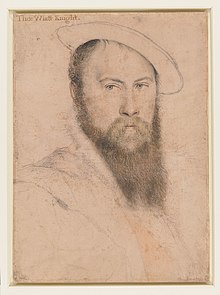
Sir Thomas Wyatt was a 16th-century English politician, ambassador, and lyric poet credited with introducing the sonnet to English literature. He was born at Allington Castle near Maidstone in Kent, though the family was originally from Yorkshire. His family adopted the Lancastrian side in the Wars of the Roses. His mother was Anne Skinner, and his father Henry, who had earlier been imprisoned and tortured by Richard III, had been a Privy Councillor of Henry VII and remained a trusted adviser when Henry VIII ascended the throne in 1509.

This article focuses on poetry from the United Kingdom written in the English language. The article does not cover poetry from other countries where the English language is spoken, including Republican Ireland after December 1922.
This article contains information about the literary events and publications of 1557.

In book publishing, an anthology is a collection of literary works chosen by the compiler; it may be a collection of plays, poems, short stories, songs or excerpts by different authors.
Barnabe Googe, also spelt Barnabe Goche and Barnaby Goodge, was a poet and translator, one of the earliest English pastoral poets.
Nicholas Grimald (1519–1562) was an English poet and dramatist.

Lady Margaret Lee was an English courtier. She was a sister of the poet Thomas Wyatt and a friend of Queen Anne Boleyn, second wife of King Henry VIII of England. Historians have speculated that she may have been present during Boleyn's execution.
The Petrarchan sonnet, also known as the Italian sonnet, is a sonnet named after the Italian poet Francesco Petrarca, although it was not developed by Petrarch himself, but rather by a string of Renaissance poets. Because of the structure of Italian, the rhyme scheme of the Petrarchan sonnet is more easily fulfilled in that language than in English. The original Italian sonnet form consists of a total of fourteen hendecasyllabic lines in two parts, the first part being an octave and the second being a sestet.

Elizabethan literature refers to bodies of work produced during the reign of Queen Elizabeth I (1558–1603), and is one of the most splendid ages of English literature. In addition to drama and the theatre, it saw a flowering of poetry, with new forms like the sonnet, the Spenserian stanza, and dramatic blank verse, as well as prose, including historical chronicles, pamphlets, and the first English novels. Major writers include William Shakespeare, Edmund Spenser, Christopher Marlowe, Richard Hooker, Ben Jonson, Philip Sidney and Thomas Kyd.
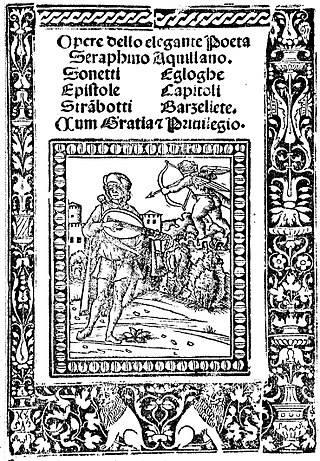
Serafino dell'Aquila or Aquilano, also called by the family name dei Ciminelli, was an Italian poet and musician. As a writer he was one of the foremost of the stylistic followers of Petrarch and his work was later influential on both French and English Petrarchan poets.

Thomas Vaux, 2nd Baron Vaux of Harrowden KB, English poet, was the eldest son of Nicholas Vaux, 1st Baron Vaux and his second wife, Anne Green, daughter of Sir Thomas Green, Lord of Nortons Green, and Joan Fogge. He was educated at Cambridge University. His mother was the maternal aunt of Queen Consort Katherine Parr, while his wife, Elizabeth Cheney, was her paternal cousin through Katherine's father's sister, Anne Parr.
Richard Tottel was an English publisher and influential member of the legal community. He ran his business from a shop located at Temple Bar on Fleet Street in London. The majority of his printing was centered on legal documents, but he is most known for a collection he edited and published in 1557 called Songes and Sonnettes.
Nationality words link to articles with information on the nation's poetry or literature.
Nationality words link to articles with information on the nation's poetry or literature.
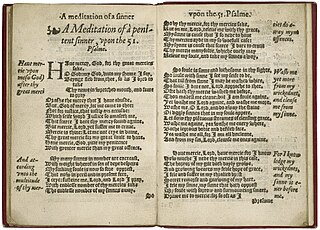
Anne Locke was an English poet, translator and Calvinist religious figure. She has been called the first English author to publish a sonnet sequence, A Meditation of a Penitent Sinner (1560), although authorship of that work has been attributed on strong grounds to Thomas Norton.
George Frederick Nott (1767–1841) was an English author and a Church of England clergyman.
"They flee from me" is a poem written by Thomas Wyatt. It is written in rhyme royal and was included in Arthur Quiller-Couch's edition of the Oxford Book of English Verse. The poem has been described as possibly autobiographical, and referring to any one of Wyatt's affairs with high-born women of the court of Henry VIII, perhaps with Anne Boleyn.
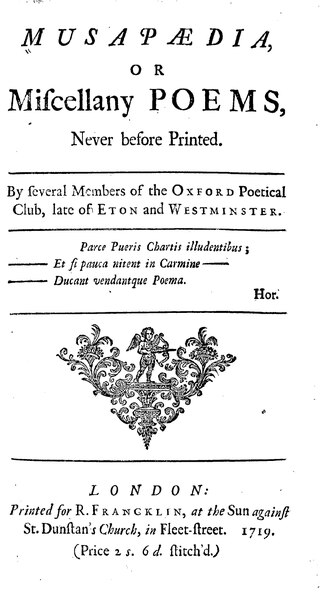
A miscellany is a collection of various pieces of writing by different authors. Meaning a mixture, medley, or assortment, a miscellany can include pieces on many subjects and in a variety of different forms. In contrast to anthologies, whose aim is to give a selective and canonical view of literature, miscellanies were produced for the entertainment of a contemporary audience and so instead emphasise collectiveness and popularity. Laura Mandell and Rita Raley state:
This last distinction is quite often visible in the basic categorical differences between anthologies on the one hand, and all other types of collections on the other, for it is in the one that we read poems of excellence, the "best of English poetry," and it is in the other that we read poems of interest. Out of the differences between a principle of selection and a principle of collection, then, comes a difference in aesthetic value, which is precisely what is at issue in the debates over the "proper" material for inclusion into the canon.
Steven W. May is an American academic and author specializing in English Renaissance poetry.
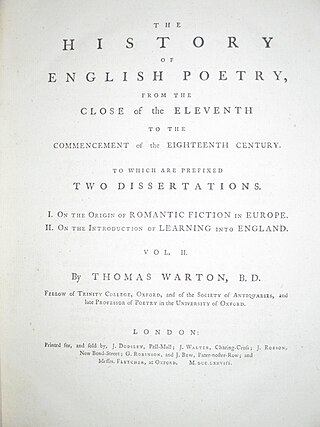
The History of English Poetry, from the Close of the Eleventh to the Commencement of the Eighteenth Century (1774-1781) by Thomas Warton was a pioneering and influential literary history. Only three full volumes were ever published, going as far as Queen Elizabeth's reign, but their account of English poetry in the Late Middle Ages and Renaissance was unrivalled for many years, and played a part in steering British literary taste towards Romanticism. It is generally acknowledged to be the first narrative English literary history.

